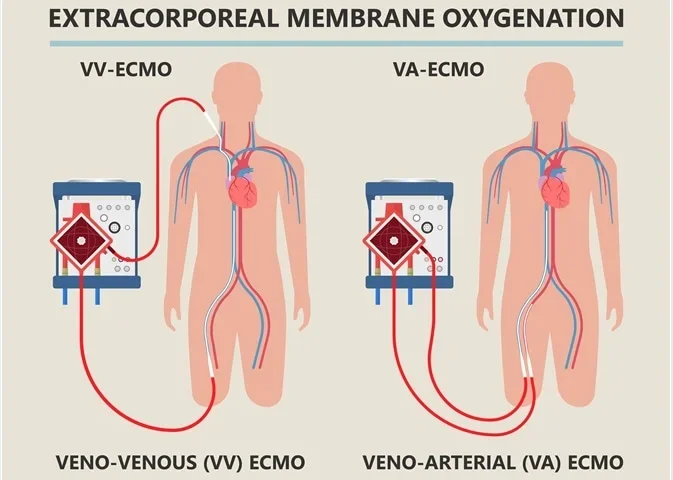ECMO – Can effectively treat Covid19 Patients

ECMO – Can effectively treat Covid19 Patients
As the world struggles to fight the covid19 pandemic there is a procedure that has been around for sometime that has possibly been overlooked. Extracorporeal membrane oxygenation or ECMO for short., also known as extracorporeal life support, is an extracorporeal technique of providing prolonged cardiac and respiratory support to persons whose heart and lungs are unable to provide an adequate amount of gas exchange or perfusion to sustain life. By supporting the heart and lungs, the ECMO machine stabilizes patients to allow their body more time to fight the virus.
How Does ECMO Work?
Originally developed in the 1960s to support newborns and infants with respiratory distress syndrome and cardiac abnormalities, ECMO has only been widely adapted for usage in adults over the last five years. The ECMO machine works by inserting a plastic tube into a large vein and/or artery through the neck, chest or groin of the patient. This tube allows for the patient’s blood to flow out into an oxygenator, or artificial lung. The oxygenator adds oxygen and removes carbon dioxide from the blood, before a pump sends this blood back into the patient through a separate tube, at the same frequency and force of the heart. Essentially, ECMO helps these patients by acting as their heart and lungs.
The machine is used when all other medical options have been exhausted for patients whose lungs can’t provide enough oxygen to their body or rid themselves of carbon dioxide. It can also be used for patients whose heart can’t pump enough blood to the body and for those waiting to either get a heart or lung transplant.
How ECMO Can Help COVID-19 Patients
Even though there’s more to learn about how COVID-19 affects the body, physicians know that it primarily affects the lungs. In certain cases, the virus can entirely overwhelm the lungs and, in turn, negatively affect the heart.
“COVID-19 is different from pneumonia or an influenza A or B because it affects all five lobes of the lung — three on the right and two on the left — and it’s patchy and diffused throughout the whole lung,” According to online articles, we are in noway medical practitioners, but we are able to understand scientific and medical research “That is where the real respiratory issues come from, as it’s damaging all areas of the lung.”
Because all five lobes of the lung are damaged, they can’t properly exchange oxygen and carbon dioxide. As carbon dioxide levels in the body increase, so does respiratory rate, as the brain tells the body to breathe more to rid itself of this carbon dioxide. However, since the lungs are damaged and are unable to so, this carbon dioxide remains in the blood and turns to acid.
A right ventricular support device (RVAD) and oxygenator within the ECMO machine is used. The RVAD is placed inside the patient through the tube that goes into the patient’s neck, down through the right atrium and right ventricle of the heart and into the pulmonary artery. This allows for blood to be taken out of the right atrium and sent to the ECMO machine. There, it’s filtered, temperature-modulated and oxygenated, and the carbon dioxide is removed. This blood then enters the body through a tube placed into the pulmonary artery.
Putting 100% oxygen into those pulmonary arteries, which is what is going out into the two lungs, “This accomplishes two things: One, it takes the load off the right side of the heart, as we are essentially bypassing it. And two, by increasing the level of oxygen going into the lungs, it decreases pulmonary vascular resistance and reduces the pressure it takes to push blood through the lungs.”
An Added Layer of Safety for COVID-19 Patients on ECMO
Certain patients with an aggressive form of COVID-19 are susceptible to a “cytokine storm,” which can cause a severe inflammatory response and multiple organ failure. This happens when a patient’s immune system malfunctions and attacks its own cells. While ECMO alone has been shown to reduce the chances of a cytokine storm, utilizing a CytoSorb Filter, a device that is used within ECMO to further reduce the cytokines and inflammatory molecules.
CytoSorb is a sterile, single-use filter that is placed into a patient’s ECMO circuit. This filter contains absorbent polymer beads that are designed to remove cytokines — what signals the immune system to work against itself — as blood passes through. This filter is then replaced routinely for a five-day course of treatment
The Earlier, the Better for ECMO
Although ECMO has already shown to be a promising way to save lives, we urge medical professionals to get patients to ECMO teams earlier, as this could save even more. Getting certain patients on ECMO sooner rather than later can avoid organ failure that physicians are seeing with COVID-19.